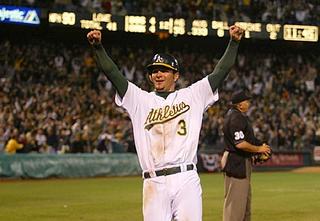Empty Spaces: Part III
| Year | Total Att. | Att. Stnd. | Wins | Loss | Pct. | AL West Stnd. | Avg. Batting Age | Avg. Pitching Age | Total Payroll | Median Salary |
| 1999 | 1,434,610 | 12th out of 14 | 87 | 75 | 0.537 | 2 | 28.7 | 31.4 | $24,150,333 | $462,500 |
| 2000 | 1,603,744 | 11th out of 14 | 91 | 70 | 0.565 | DIV 1 | 27.1 | 29.5 | $32,121,833 | $400,000 |
| 2001 | 2,133,277 | 7th out of 14 | 102 | 60 | 0.630 | WC 2 | 27.1 | 28.0 | $33,810,750 | $350,000 |
| 2002 | 2,169,811 | 8th out of 14 | 103 | 59 | 0.636 | DIV 1 | 28.4 | 27.4 | $40,004,167 | $812,500 |
| 2003 | 2,216,596 | 6th out of 14 | 96 | 66 | 0.593 | DIV 1 | 28.1 | 27.4 | $50,260,834 | $1,032,500 |
| 2004 | 2,201,516 | 7th out of 14 | 91 | 71 | 0.562 | 2 | 29.6 | 28.4 | $59,425,667 | $1,357,500 |
| 2005 | 1,927,201 | 8th out of 14 | 84 | 68 | 0.553 | N/A | 28.9* | 28.1* | $55,425,762 | $591,667 |
| *: Not Weighted | ||||||||||
1999 marked the beginning of a new era in A’s baseball. With the emergence of rookie starter Tim Hudson and first-baseman Jason Giambi, it was the first season that the A’s were over the five-hundred mark since 1992. It also had the highest attendance figure since 1993. With the winning season of 1999 followed up by a division championship in 2000, the A’s attendance went up by 200k each year. And in 2001, the A’s crossed the 2 million-plus attendance figure since 1993. And with the winning, came the playoff berths.
Oct. | TIME | OPPONENT | REC | ATT |
Tue. | 5:05 | NY | 1-0 | 47,360 |
Wed. | 5:05 | NY | 1-1 | 47,860 |
Fri. | 5:05 | at | 1-2 | 56,606 |
Sat. | 4:30 | at | 2-2 | 56,915 |
Sun. | 5:05 | NY | 2-3 | 41,170 |
Oct. | TIME | OPPONENT | REC | ATT |
Wed. | 5:05 | at | 1-0 | 56,697 |
Thu. | 5:05 | at | 2-0 | 56,684 |
Sat. | 4:30 | NY | 2-1 | 55,861 |
Sun. | 1:30 | NY | 2-2 | 43,681 |
Mon. | 5:05 | at | 2-3 | 56,642 |
Oct. | TIME | OPPONENT | REC | ATT |
Tue. | 1:05 | Minnesota | 0-1 | 34,853 |
Wed. | 1:05 | Minnesota | 1-1 | 31,953 |
Fri. | 1:05 | at | 2-1 | 55,932 |
Sat. | 10:05 | at | 2-2 | 55,960 |
Sun. | 1:05 | Minnesota | 2-3 | 32,146 |
Oct. | TIME | OPPONENT | REC | ATT |
Wed. | 7:05 | Boston | 1-0 | 50,606 |
Thu. | 1:05 | Boston | 2-0 | 36,305 |
Sat. | 5:05 | at | 2-1 | 35,460 |
Sun. | 10:05 | at | 2-2 | 35,048 |
Mon. | 5:05 | Boston | 2-3 | 49,397 |
If you look at the attendance numbers of the 2002 ALDS vs. the Minnesota Twins, the A’s could not attract people to the park solely based on their making the playoffs. But a circumstance to consider is that all the A’s home games during that series were played in the day time and that the final game on Sunday was played when the Niners were at home playing against the A’s for the same time slot and the Giants were going to play their playoff game at 4:30. There was also the issue of the ticket pricing; the cheapest seat for the 2002 division series was $35 dollars.
Now that the A’s have had seven straight years of winning seasons, apparently, that is not enough for the casual fan in the Bay Area. The A’s have already been labeled as chokers due to their playoff collapses and as such, it could be that the A’s have seen drop-offs in both the 2004 and 2005 season because of the stigma.
It’s well known that the A’s draw well when their opponents are top-draws like the Yankees and the Red-Sox. But if you look at the attendance numbers this year, you can see a correlation between winning and the attendance per game:
The first series is the Attendance numbers through games; the second is the difference in winning percentage between the A’s and their opponents, or d-WP%. When the winning percentage was -.100 or less, the attendance was very low and conversely, the attendance was low when the d-WP% was +.100 or more. The only times the numbers deviated were due to noted events such as promotions on these games. So even though the A’s had a winning season in 2005, they could not draw by solely on their merits.










